Leadership and Management
VerifiedAdded on 2023/01/17
|10
|2417
|65
AI Summary
This document discusses the importance of positive leadership behavior, emotional intelligence, and cultural diversity in the workplace. It also explores the role of emotional intelligence in decision-making and the legal and ethical considerations in managing employees.
Contribute Materials
Your contribution can guide someone’s learning journey. Share your
documents today.
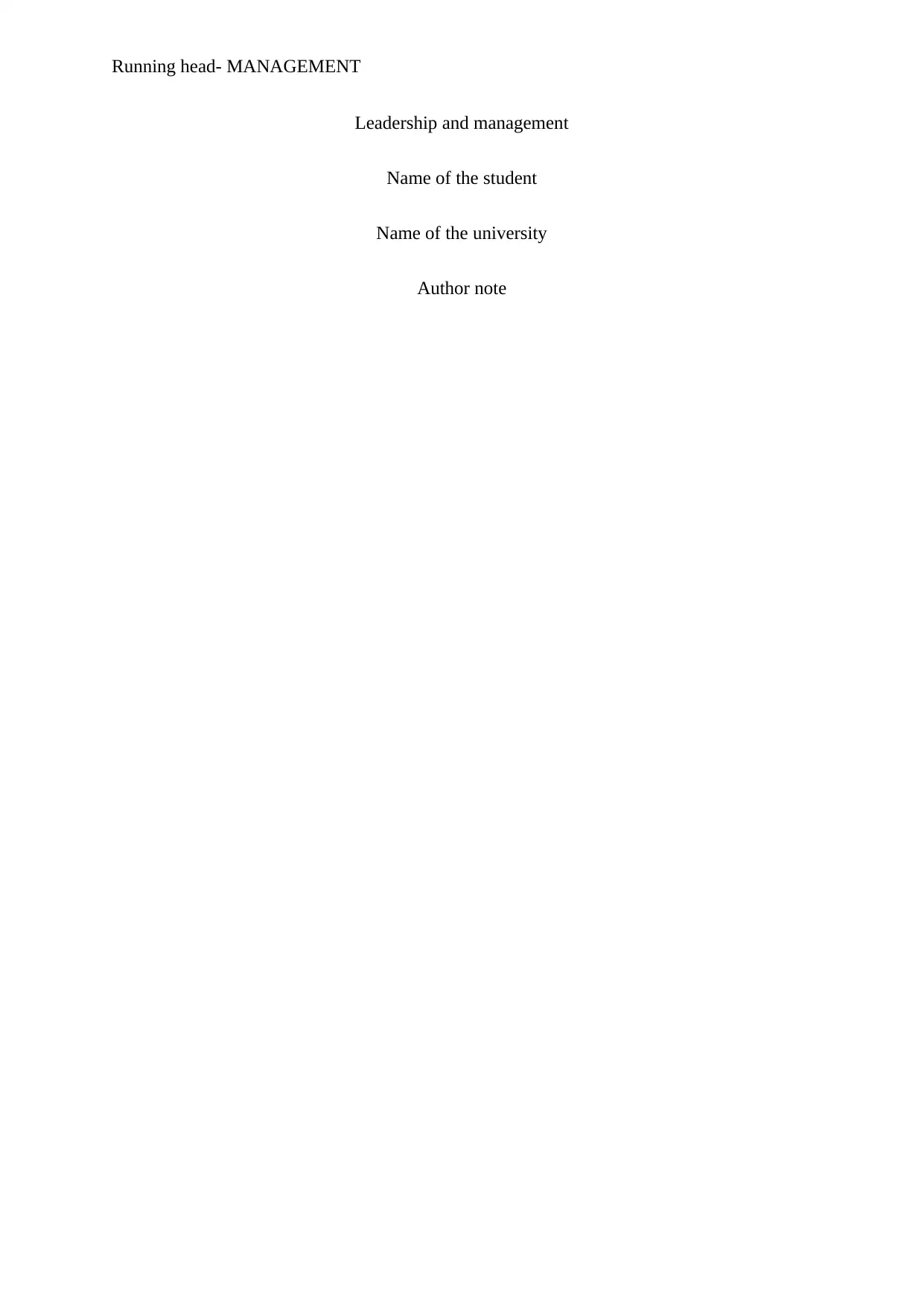
Running head- MANAGEMENT
Leadership and management
Name of the student
Name of the university
Author note
Leadership and management
Name of the student
Name of the university
Author note
Secure Best Marks with AI Grader
Need help grading? Try our AI Grader for instant feedback on your assignments.
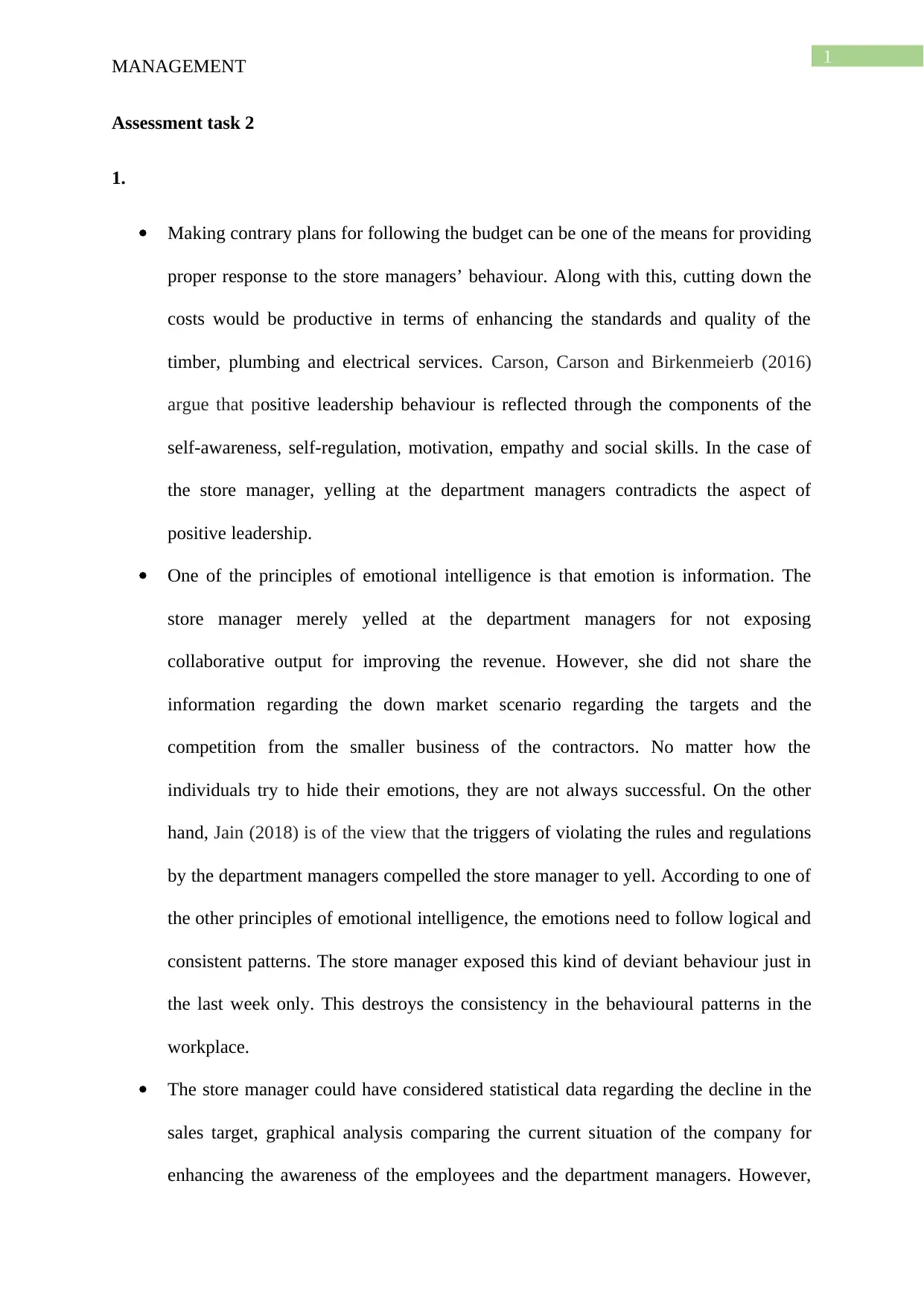
1
MANAGEMENT
Assessment task 2
1.
Making contrary plans for following the budget can be one of the means for providing
proper response to the store managers’ behaviour. Along with this, cutting down the
costs would be productive in terms of enhancing the standards and quality of the
timber, plumbing and electrical services. Carson, Carson and Birkenmeierb (2016)
argue that positive leadership behaviour is reflected through the components of the
self-awareness, self-regulation, motivation, empathy and social skills. In the case of
the store manager, yelling at the department managers contradicts the aspect of
positive leadership.
One of the principles of emotional intelligence is that emotion is information. The
store manager merely yelled at the department managers for not exposing
collaborative output for improving the revenue. However, she did not share the
information regarding the down market scenario regarding the targets and the
competition from the smaller business of the contractors. No matter how the
individuals try to hide their emotions, they are not always successful. On the other
hand, Jain (2018) is of the view that the triggers of violating the rules and regulations
by the department managers compelled the store manager to yell. According to one of
the other principles of emotional intelligence, the emotions need to follow logical and
consistent patterns. The store manager exposed this kind of deviant behaviour just in
the last week only. This destroys the consistency in the behavioural patterns in the
workplace.
The store manager could have considered statistical data regarding the decline in the
sales target, graphical analysis comparing the current situation of the company for
enhancing the awareness of the employees and the department managers. However,
MANAGEMENT
Assessment task 2
1.
Making contrary plans for following the budget can be one of the means for providing
proper response to the store managers’ behaviour. Along with this, cutting down the
costs would be productive in terms of enhancing the standards and quality of the
timber, plumbing and electrical services. Carson, Carson and Birkenmeierb (2016)
argue that positive leadership behaviour is reflected through the components of the
self-awareness, self-regulation, motivation, empathy and social skills. In the case of
the store manager, yelling at the department managers contradicts the aspect of
positive leadership.
One of the principles of emotional intelligence is that emotion is information. The
store manager merely yelled at the department managers for not exposing
collaborative output for improving the revenue. However, she did not share the
information regarding the down market scenario regarding the targets and the
competition from the smaller business of the contractors. No matter how the
individuals try to hide their emotions, they are not always successful. On the other
hand, Jain (2018) is of the view that the triggers of violating the rules and regulations
by the department managers compelled the store manager to yell. According to one of
the other principles of emotional intelligence, the emotions need to follow logical and
consistent patterns. The store manager exposed this kind of deviant behaviour just in
the last week only. This destroys the consistency in the behavioural patterns in the
workplace.
The store manager could have considered statistical data regarding the decline in the
sales target, graphical analysis comparing the current situation of the company for
enhancing the awareness of the employees and the department managers. However,
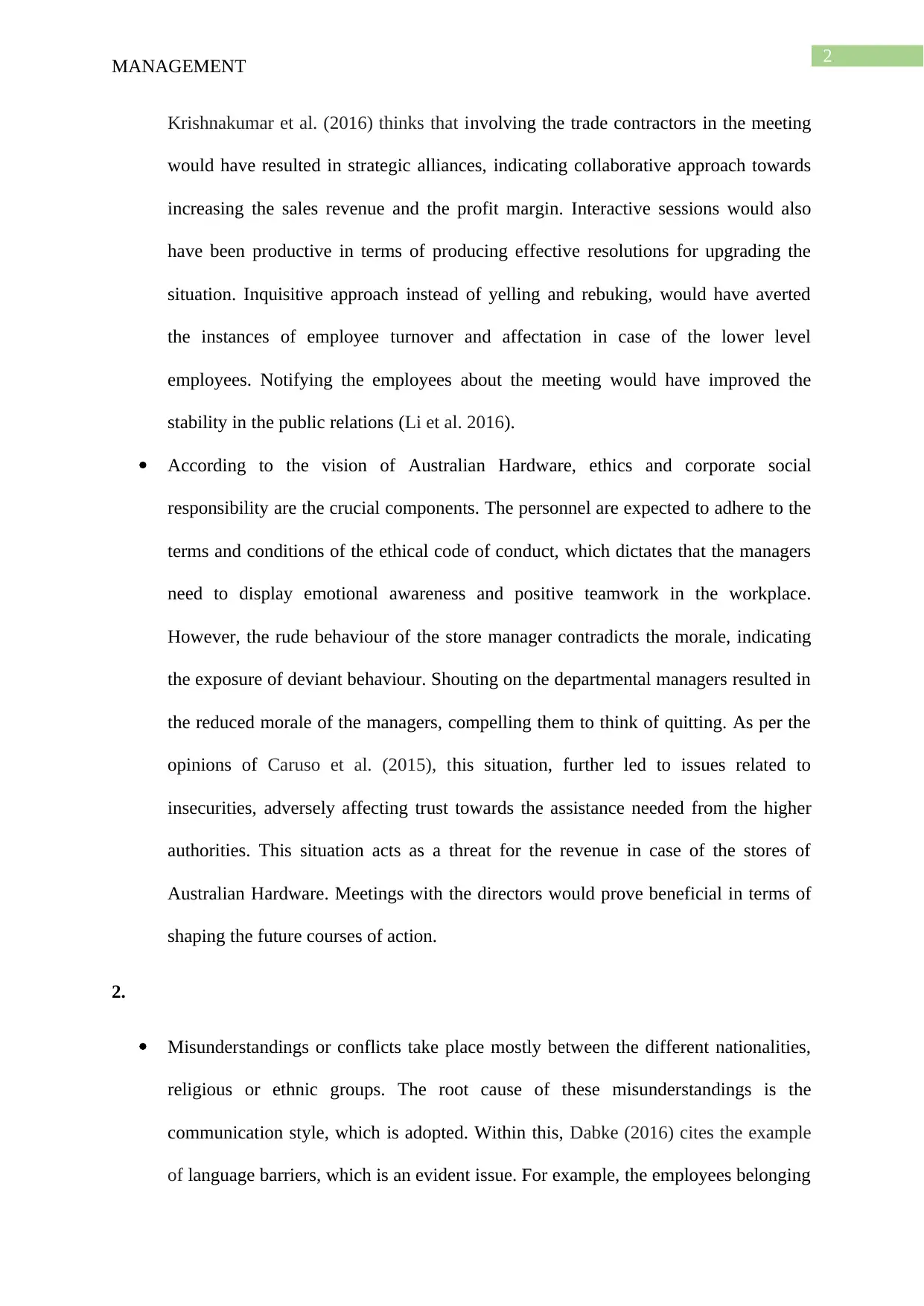
2
MANAGEMENT
Krishnakumar et al. (2016) thinks that involving the trade contractors in the meeting
would have resulted in strategic alliances, indicating collaborative approach towards
increasing the sales revenue and the profit margin. Interactive sessions would also
have been productive in terms of producing effective resolutions for upgrading the
situation. Inquisitive approach instead of yelling and rebuking, would have averted
the instances of employee turnover and affectation in case of the lower level
employees. Notifying the employees about the meeting would have improved the
stability in the public relations (Li et al. 2016).
According to the vision of Australian Hardware, ethics and corporate social
responsibility are the crucial components. The personnel are expected to adhere to the
terms and conditions of the ethical code of conduct, which dictates that the managers
need to display emotional awareness and positive teamwork in the workplace.
However, the rude behaviour of the store manager contradicts the morale, indicating
the exposure of deviant behaviour. Shouting on the departmental managers resulted in
the reduced morale of the managers, compelling them to think of quitting. As per the
opinions of Caruso et al. (2015), this situation, further led to issues related to
insecurities, adversely affecting trust towards the assistance needed from the higher
authorities. This situation acts as a threat for the revenue in case of the stores of
Australian Hardware. Meetings with the directors would prove beneficial in terms of
shaping the future courses of action.
2.
Misunderstandings or conflicts take place mostly between the different nationalities,
religious or ethnic groups. The root cause of these misunderstandings is the
communication style, which is adopted. Within this, Dabke (2016) cites the example
of language barriers, which is an evident issue. For example, the employees belonging
MANAGEMENT
Krishnakumar et al. (2016) thinks that involving the trade contractors in the meeting
would have resulted in strategic alliances, indicating collaborative approach towards
increasing the sales revenue and the profit margin. Interactive sessions would also
have been productive in terms of producing effective resolutions for upgrading the
situation. Inquisitive approach instead of yelling and rebuking, would have averted
the instances of employee turnover and affectation in case of the lower level
employees. Notifying the employees about the meeting would have improved the
stability in the public relations (Li et al. 2016).
According to the vision of Australian Hardware, ethics and corporate social
responsibility are the crucial components. The personnel are expected to adhere to the
terms and conditions of the ethical code of conduct, which dictates that the managers
need to display emotional awareness and positive teamwork in the workplace.
However, the rude behaviour of the store manager contradicts the morale, indicating
the exposure of deviant behaviour. Shouting on the departmental managers resulted in
the reduced morale of the managers, compelling them to think of quitting. As per the
opinions of Caruso et al. (2015), this situation, further led to issues related to
insecurities, adversely affecting trust towards the assistance needed from the higher
authorities. This situation acts as a threat for the revenue in case of the stores of
Australian Hardware. Meetings with the directors would prove beneficial in terms of
shaping the future courses of action.
2.
Misunderstandings or conflicts take place mostly between the different nationalities,
religious or ethnic groups. The root cause of these misunderstandings is the
communication style, which is adopted. Within this, Dabke (2016) cites the example
of language barriers, which is an evident issue. For example, the employees belonging

3
MANAGEMENT
to the Japanese culture would not understand the language spoken by the employee
hailing to the Australian culture, unless he has sound proficiency towards the
language. This is one of the instances, where the employees would not understand
what the other person intends to communicate. This leads to difference of opinions,
leading to conflicts, which degrades the sanctity of the workplace. Lack of
understanding results in the misinterpretation of the orders, resulting in the exposure
of performance, which is deviant from the identified and the specified requirements.
This situation affects the cultural diversity of the workplace (Khalili 2017).
At the initial stage, I would convince the employee that the culture, customs and
traditions of the workplaces differ from country to country. In this process, I would
make her learn that she needs to adjust within the given workplace environment in
order to gain mutual understanding from the employees. I would offer practical
examples regarding the misinterpretation of the cultural expressions, which would
enhance her awareness about the issues, which she might face in the workplace. I
would convince her that understanding approach and patience would be the key
elements in terms of averting the instances of cultural expressions being
misinterpreted. She needs to be assured that such cases are common in the workplace,
which needs to be dealt tactfully and rationally for gaining trust, loyalty and
dependence from the others.
Group interactions are one of the effective means through which the awareness of
cultural expressions can be enhanced. Through these interactions, the employees
would get to know about the culture, customs and traditions of each other. Infusing
the ethical code of conduct would generate respect among the employees regarding
the other cultures. Within this, Caruso et al. (2015) opines that adopting the style of
open communication would be effective in terms of providing the team members with
MANAGEMENT
to the Japanese culture would not understand the language spoken by the employee
hailing to the Australian culture, unless he has sound proficiency towards the
language. This is one of the instances, where the employees would not understand
what the other person intends to communicate. This leads to difference of opinions,
leading to conflicts, which degrades the sanctity of the workplace. Lack of
understanding results in the misinterpretation of the orders, resulting in the exposure
of performance, which is deviant from the identified and the specified requirements.
This situation affects the cultural diversity of the workplace (Khalili 2017).
At the initial stage, I would convince the employee that the culture, customs and
traditions of the workplaces differ from country to country. In this process, I would
make her learn that she needs to adjust within the given workplace environment in
order to gain mutual understanding from the employees. I would offer practical
examples regarding the misinterpretation of the cultural expressions, which would
enhance her awareness about the issues, which she might face in the workplace. I
would convince her that understanding approach and patience would be the key
elements in terms of averting the instances of cultural expressions being
misinterpreted. She needs to be assured that such cases are common in the workplace,
which needs to be dealt tactfully and rationally for gaining trust, loyalty and
dependence from the others.
Group interactions are one of the effective means through which the awareness of
cultural expressions can be enhanced. Through these interactions, the employees
would get to know about the culture, customs and traditions of each other. Infusing
the ethical code of conduct would generate respect among the employees regarding
the other cultures. Within this, Caruso et al. (2015) opines that adopting the style of
open communication would be effective in terms of providing the team members with
Secure Best Marks with AI Grader
Need help grading? Try our AI Grader for instant feedback on your assignments.
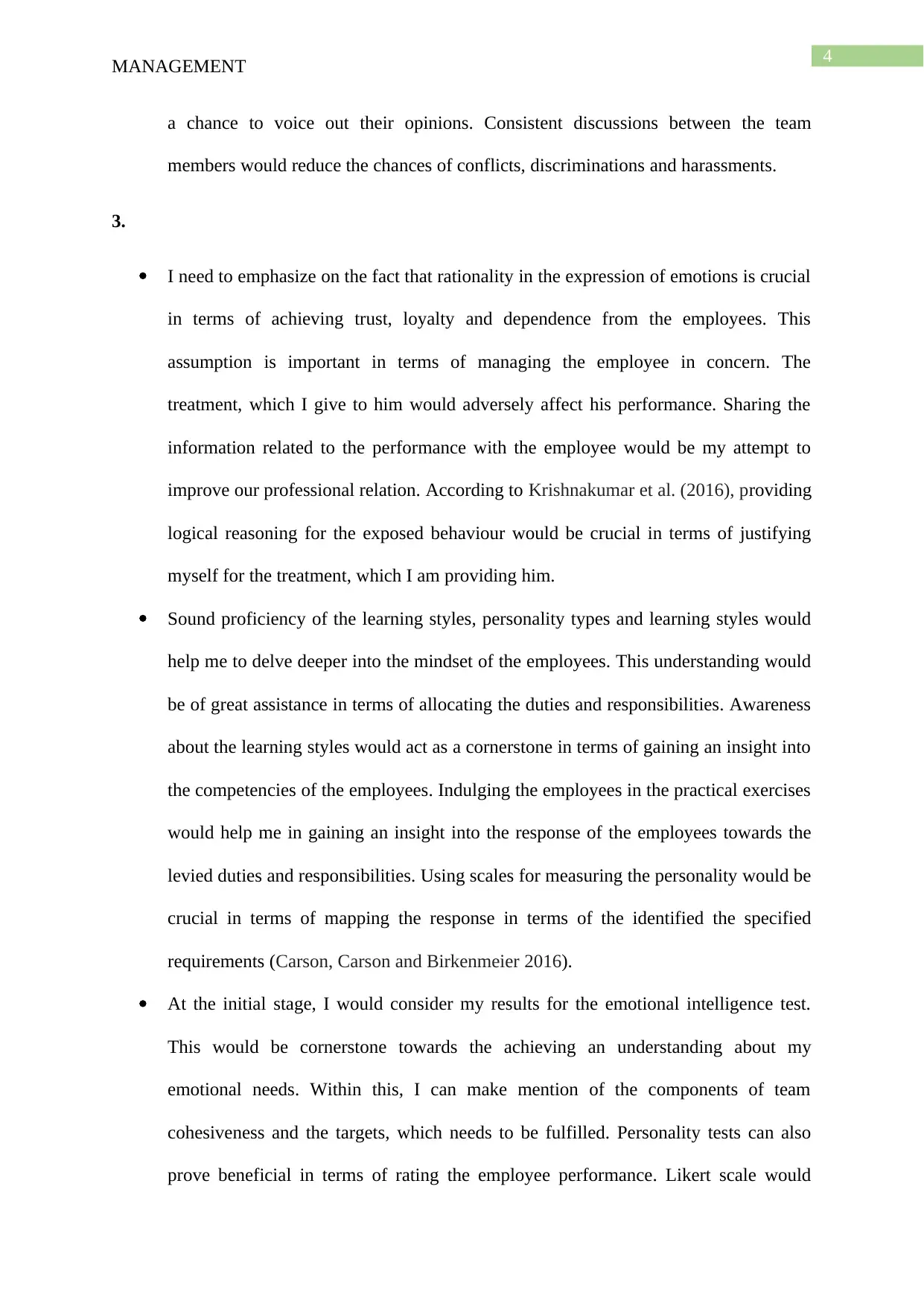
4
MANAGEMENT
a chance to voice out their opinions. Consistent discussions between the team
members would reduce the chances of conflicts, discriminations and harassments.
3.
I need to emphasize on the fact that rationality in the expression of emotions is crucial
in terms of achieving trust, loyalty and dependence from the employees. This
assumption is important in terms of managing the employee in concern. The
treatment, which I give to him would adversely affect his performance. Sharing the
information related to the performance with the employee would be my attempt to
improve our professional relation. According to Krishnakumar et al. (2016), providing
logical reasoning for the exposed behaviour would be crucial in terms of justifying
myself for the treatment, which I am providing him.
Sound proficiency of the learning styles, personality types and learning styles would
help me to delve deeper into the mindset of the employees. This understanding would
be of great assistance in terms of allocating the duties and responsibilities. Awareness
about the learning styles would act as a cornerstone in terms of gaining an insight into
the competencies of the employees. Indulging the employees in the practical exercises
would help me in gaining an insight into the response of the employees towards the
levied duties and responsibilities. Using scales for measuring the personality would be
crucial in terms of mapping the response in terms of the identified the specified
requirements (Carson, Carson and Birkenmeier 2016).
At the initial stage, I would consider my results for the emotional intelligence test.
This would be cornerstone towards the achieving an understanding about my
emotional needs. Within this, I can make mention of the components of team
cohesiveness and the targets, which needs to be fulfilled. Personality tests can also
prove beneficial in terms of rating the employee performance. Likert scale would
MANAGEMENT
a chance to voice out their opinions. Consistent discussions between the team
members would reduce the chances of conflicts, discriminations and harassments.
3.
I need to emphasize on the fact that rationality in the expression of emotions is crucial
in terms of achieving trust, loyalty and dependence from the employees. This
assumption is important in terms of managing the employee in concern. The
treatment, which I give to him would adversely affect his performance. Sharing the
information related to the performance with the employee would be my attempt to
improve our professional relation. According to Krishnakumar et al. (2016), providing
logical reasoning for the exposed behaviour would be crucial in terms of justifying
myself for the treatment, which I am providing him.
Sound proficiency of the learning styles, personality types and learning styles would
help me to delve deeper into the mindset of the employees. This understanding would
be of great assistance in terms of allocating the duties and responsibilities. Awareness
about the learning styles would act as a cornerstone in terms of gaining an insight into
the competencies of the employees. Indulging the employees in the practical exercises
would help me in gaining an insight into the response of the employees towards the
levied duties and responsibilities. Using scales for measuring the personality would be
crucial in terms of mapping the response in terms of the identified the specified
requirements (Carson, Carson and Birkenmeier 2016).
At the initial stage, I would consider my results for the emotional intelligence test.
This would be cornerstone towards the achieving an understanding about my
emotional needs. Within this, I can make mention of the components of team
cohesiveness and the targets, which needs to be fulfilled. Personality tests can also
prove beneficial in terms of rating the employee performance. Likert scale would
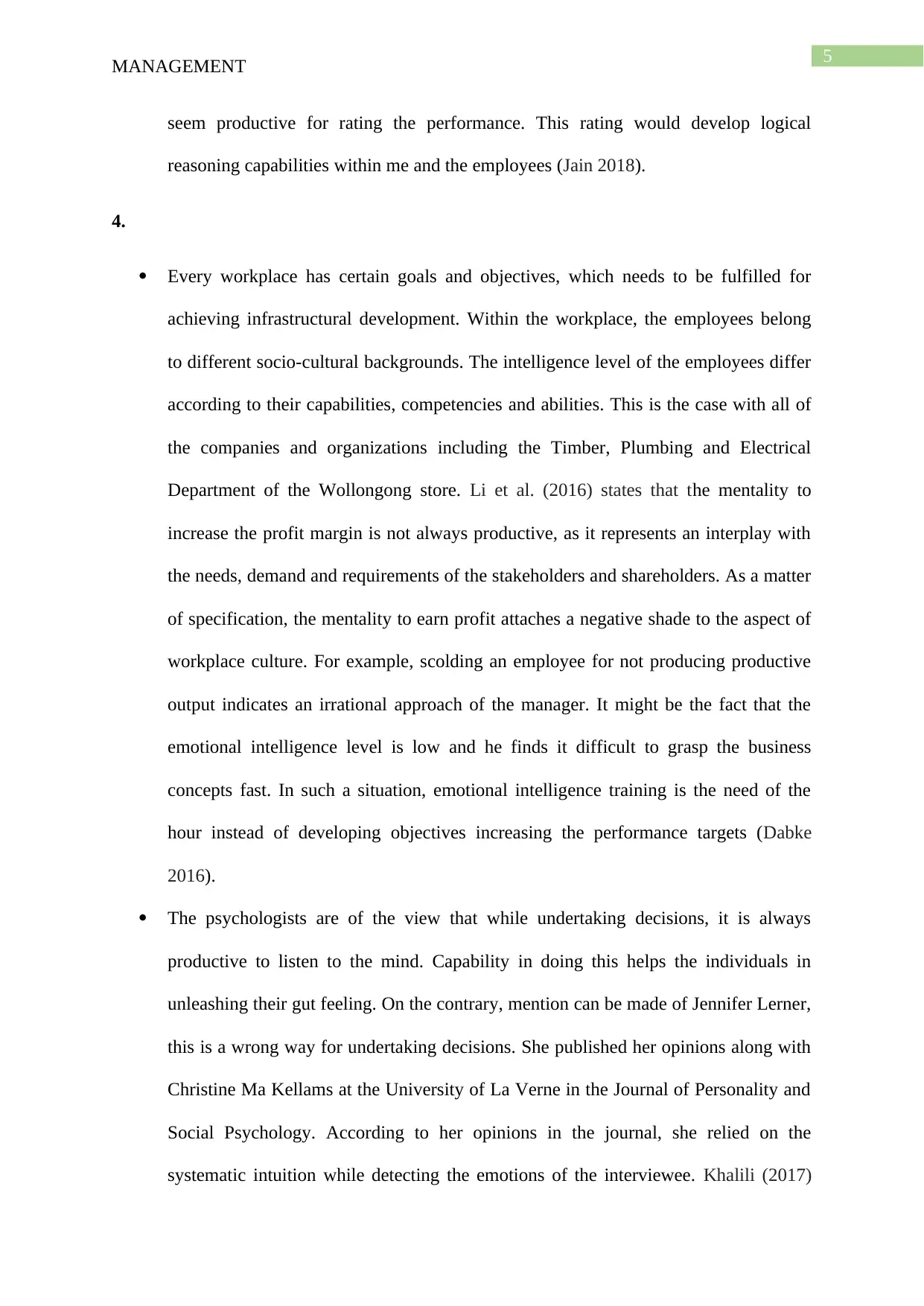
5
MANAGEMENT
seem productive for rating the performance. This rating would develop logical
reasoning capabilities within me and the employees (Jain 2018).
4.
Every workplace has certain goals and objectives, which needs to be fulfilled for
achieving infrastructural development. Within the workplace, the employees belong
to different socio-cultural backgrounds. The intelligence level of the employees differ
according to their capabilities, competencies and abilities. This is the case with all of
the companies and organizations including the Timber, Plumbing and Electrical
Department of the Wollongong store. Li et al. (2016) states that the mentality to
increase the profit margin is not always productive, as it represents an interplay with
the needs, demand and requirements of the stakeholders and shareholders. As a matter
of specification, the mentality to earn profit attaches a negative shade to the aspect of
workplace culture. For example, scolding an employee for not producing productive
output indicates an irrational approach of the manager. It might be the fact that the
emotional intelligence level is low and he finds it difficult to grasp the business
concepts fast. In such a situation, emotional intelligence training is the need of the
hour instead of developing objectives increasing the performance targets (Dabke
2016).
The psychologists are of the view that while undertaking decisions, it is always
productive to listen to the mind. Capability in doing this helps the individuals in
unleashing their gut feeling. On the contrary, mention can be made of Jennifer Lerner,
this is a wrong way for undertaking decisions. She published her opinions along with
Christine Ma Kellams at the University of La Verne in the Journal of Personality and
Social Psychology. According to her opinions in the journal, she relied on the
systematic intuition while detecting the emotions of the interviewee. Khalili (2017)
MANAGEMENT
seem productive for rating the performance. This rating would develop logical
reasoning capabilities within me and the employees (Jain 2018).
4.
Every workplace has certain goals and objectives, which needs to be fulfilled for
achieving infrastructural development. Within the workplace, the employees belong
to different socio-cultural backgrounds. The intelligence level of the employees differ
according to their capabilities, competencies and abilities. This is the case with all of
the companies and organizations including the Timber, Plumbing and Electrical
Department of the Wollongong store. Li et al. (2016) states that the mentality to
increase the profit margin is not always productive, as it represents an interplay with
the needs, demand and requirements of the stakeholders and shareholders. As a matter
of specification, the mentality to earn profit attaches a negative shade to the aspect of
workplace culture. For example, scolding an employee for not producing productive
output indicates an irrational approach of the manager. It might be the fact that the
emotional intelligence level is low and he finds it difficult to grasp the business
concepts fast. In such a situation, emotional intelligence training is the need of the
hour instead of developing objectives increasing the performance targets (Dabke
2016).
The psychologists are of the view that while undertaking decisions, it is always
productive to listen to the mind. Capability in doing this helps the individuals in
unleashing their gut feeling. On the contrary, mention can be made of Jennifer Lerner,
this is a wrong way for undertaking decisions. She published her opinions along with
Christine Ma Kellams at the University of La Verne in the Journal of Personality and
Social Psychology. According to her opinions in the journal, she relied on the
systematic intuition while detecting the emotions of the interviewee. Khalili (2017)
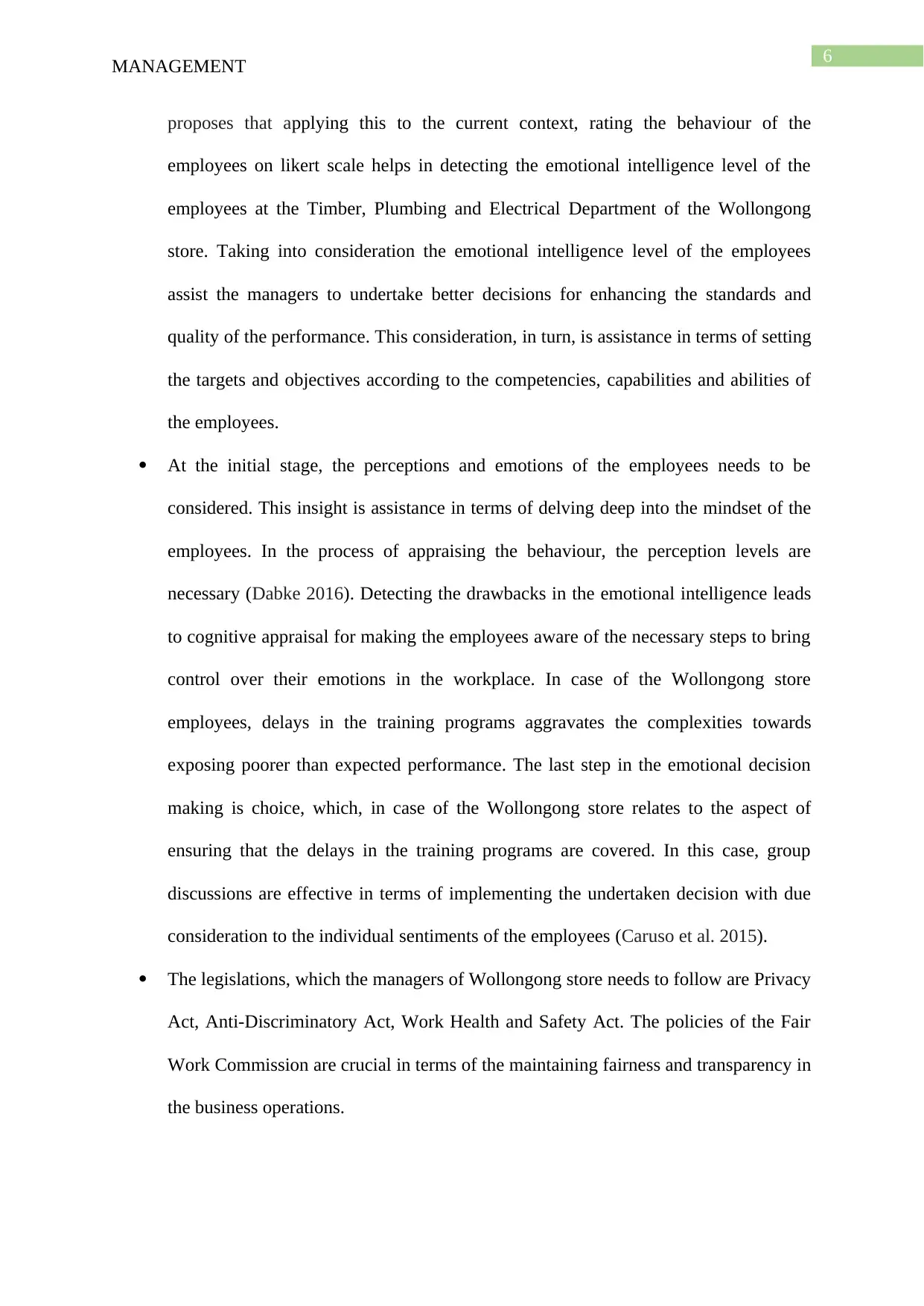
6
MANAGEMENT
proposes that applying this to the current context, rating the behaviour of the
employees on likert scale helps in detecting the emotional intelligence level of the
employees at the Timber, Plumbing and Electrical Department of the Wollongong
store. Taking into consideration the emotional intelligence level of the employees
assist the managers to undertake better decisions for enhancing the standards and
quality of the performance. This consideration, in turn, is assistance in terms of setting
the targets and objectives according to the competencies, capabilities and abilities of
the employees.
At the initial stage, the perceptions and emotions of the employees needs to be
considered. This insight is assistance in terms of delving deep into the mindset of the
employees. In the process of appraising the behaviour, the perception levels are
necessary (Dabke 2016). Detecting the drawbacks in the emotional intelligence leads
to cognitive appraisal for making the employees aware of the necessary steps to bring
control over their emotions in the workplace. In case of the Wollongong store
employees, delays in the training programs aggravates the complexities towards
exposing poorer than expected performance. The last step in the emotional decision
making is choice, which, in case of the Wollongong store relates to the aspect of
ensuring that the delays in the training programs are covered. In this case, group
discussions are effective in terms of implementing the undertaken decision with due
consideration to the individual sentiments of the employees (Caruso et al. 2015).
The legislations, which the managers of Wollongong store needs to follow are Privacy
Act, Anti-Discriminatory Act, Work Health and Safety Act. The policies of the Fair
Work Commission are crucial in terms of the maintaining fairness and transparency in
the business operations.
MANAGEMENT
proposes that applying this to the current context, rating the behaviour of the
employees on likert scale helps in detecting the emotional intelligence level of the
employees at the Timber, Plumbing and Electrical Department of the Wollongong
store. Taking into consideration the emotional intelligence level of the employees
assist the managers to undertake better decisions for enhancing the standards and
quality of the performance. This consideration, in turn, is assistance in terms of setting
the targets and objectives according to the competencies, capabilities and abilities of
the employees.
At the initial stage, the perceptions and emotions of the employees needs to be
considered. This insight is assistance in terms of delving deep into the mindset of the
employees. In the process of appraising the behaviour, the perception levels are
necessary (Dabke 2016). Detecting the drawbacks in the emotional intelligence leads
to cognitive appraisal for making the employees aware of the necessary steps to bring
control over their emotions in the workplace. In case of the Wollongong store
employees, delays in the training programs aggravates the complexities towards
exposing poorer than expected performance. The last step in the emotional decision
making is choice, which, in case of the Wollongong store relates to the aspect of
ensuring that the delays in the training programs are covered. In this case, group
discussions are effective in terms of implementing the undertaken decision with due
consideration to the individual sentiments of the employees (Caruso et al. 2015).
The legislations, which the managers of Wollongong store needs to follow are Privacy
Act, Anti-Discriminatory Act, Work Health and Safety Act. The policies of the Fair
Work Commission are crucial in terms of the maintaining fairness and transparency in
the business operations.
Paraphrase This Document
Need a fresh take? Get an instant paraphrase of this document with our AI Paraphraser
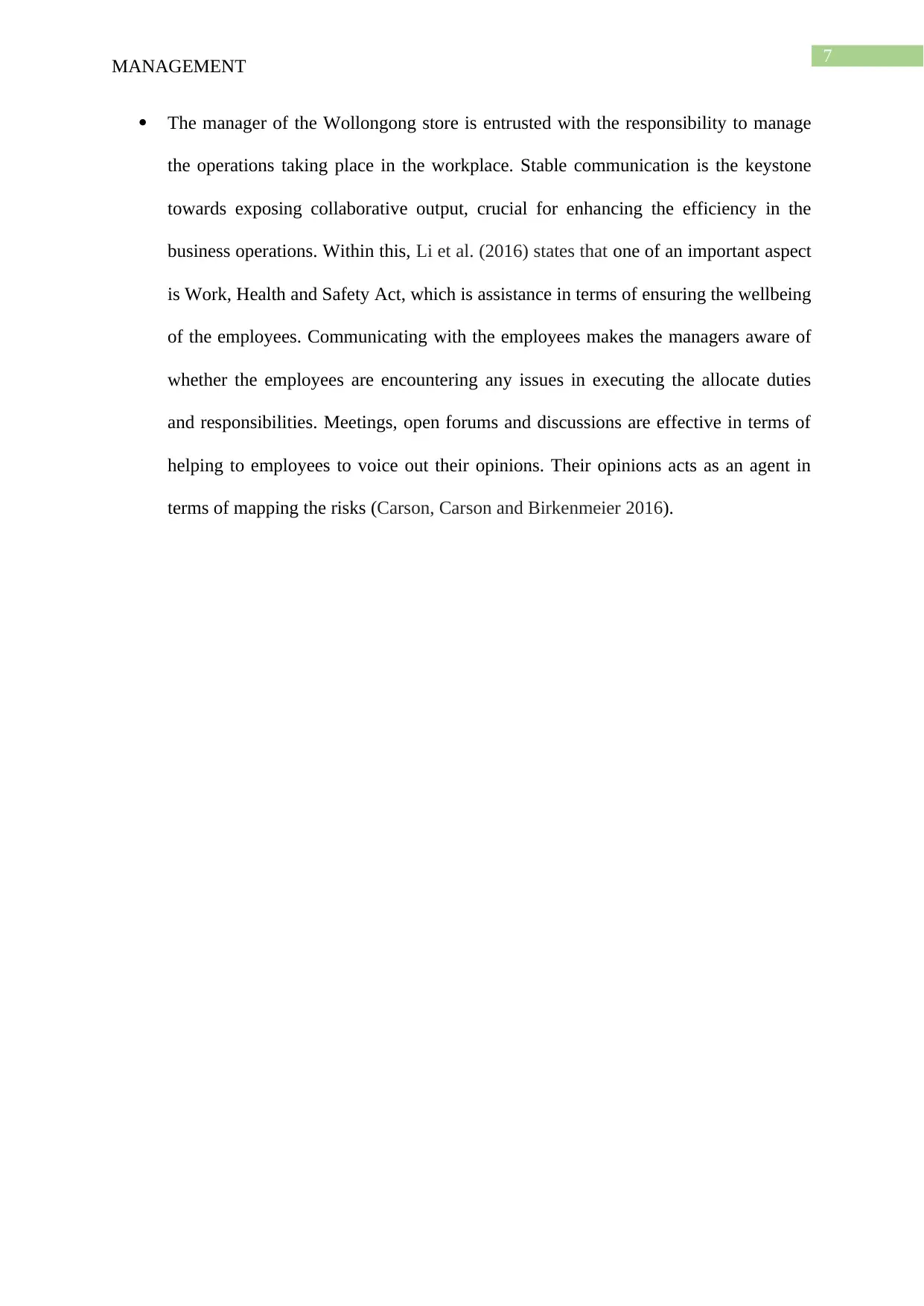
7
MANAGEMENT
The manager of the Wollongong store is entrusted with the responsibility to manage
the operations taking place in the workplace. Stable communication is the keystone
towards exposing collaborative output, crucial for enhancing the efficiency in the
business operations. Within this, Li et al. (2016) states that one of an important aspect
is Work, Health and Safety Act, which is assistance in terms of ensuring the wellbeing
of the employees. Communicating with the employees makes the managers aware of
whether the employees are encountering any issues in executing the allocate duties
and responsibilities. Meetings, open forums and discussions are effective in terms of
helping to employees to voice out their opinions. Their opinions acts as an agent in
terms of mapping the risks (Carson, Carson and Birkenmeier 2016).
MANAGEMENT
The manager of the Wollongong store is entrusted with the responsibility to manage
the operations taking place in the workplace. Stable communication is the keystone
towards exposing collaborative output, crucial for enhancing the efficiency in the
business operations. Within this, Li et al. (2016) states that one of an important aspect
is Work, Health and Safety Act, which is assistance in terms of ensuring the wellbeing
of the employees. Communicating with the employees makes the managers aware of
whether the employees are encountering any issues in executing the allocate duties
and responsibilities. Meetings, open forums and discussions are effective in terms of
helping to employees to voice out their opinions. Their opinions acts as an agent in
terms of mapping the risks (Carson, Carson and Birkenmeier 2016).
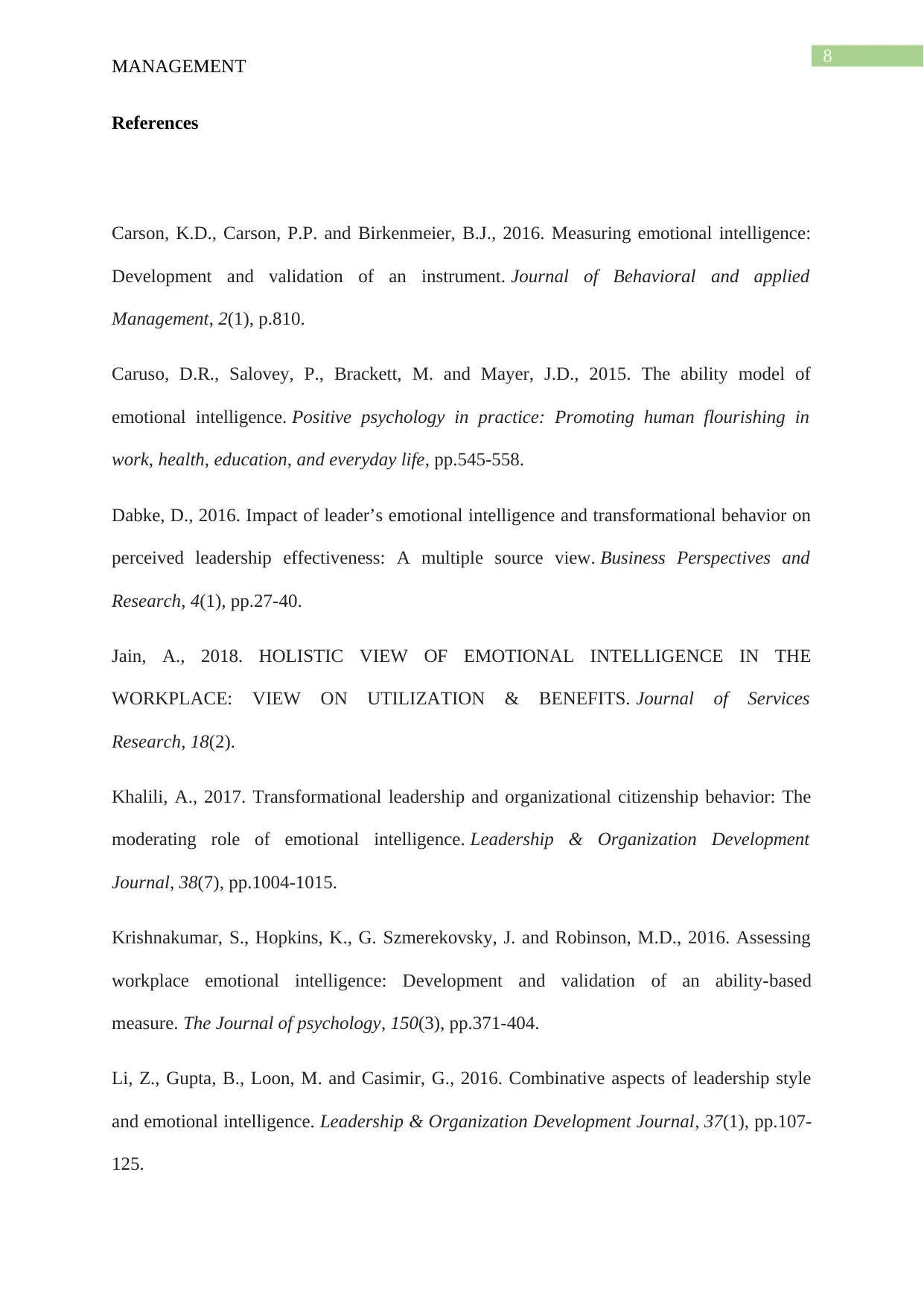
8
MANAGEMENT
References
Carson, K.D., Carson, P.P. and Birkenmeier, B.J., 2016. Measuring emotional intelligence:
Development and validation of an instrument. Journal of Behavioral and applied
Management, 2(1), p.810.
Caruso, D.R., Salovey, P., Brackett, M. and Mayer, J.D., 2015. The ability model of
emotional intelligence. Positive psychology in practice: Promoting human flourishing in
work, health, education, and everyday life, pp.545-558.
Dabke, D., 2016. Impact of leader’s emotional intelligence and transformational behavior on
perceived leadership effectiveness: A multiple source view. Business Perspectives and
Research, 4(1), pp.27-40.
Jain, A., 2018. HOLISTIC VIEW OF EMOTIONAL INTELLIGENCE IN THE
WORKPLACE: VIEW ON UTILIZATION & BENEFITS. Journal of Services
Research, 18(2).
Khalili, A., 2017. Transformational leadership and organizational citizenship behavior: The
moderating role of emotional intelligence. Leadership & Organization Development
Journal, 38(7), pp.1004-1015.
Krishnakumar, S., Hopkins, K., G. Szmerekovsky, J. and Robinson, M.D., 2016. Assessing
workplace emotional intelligence: Development and validation of an ability-based
measure. The Journal of psychology, 150(3), pp.371-404.
Li, Z., Gupta, B., Loon, M. and Casimir, G., 2016. Combinative aspects of leadership style
and emotional intelligence. Leadership & Organization Development Journal, 37(1), pp.107-
125.
MANAGEMENT
References
Carson, K.D., Carson, P.P. and Birkenmeier, B.J., 2016. Measuring emotional intelligence:
Development and validation of an instrument. Journal of Behavioral and applied
Management, 2(1), p.810.
Caruso, D.R., Salovey, P., Brackett, M. and Mayer, J.D., 2015. The ability model of
emotional intelligence. Positive psychology in practice: Promoting human flourishing in
work, health, education, and everyday life, pp.545-558.
Dabke, D., 2016. Impact of leader’s emotional intelligence and transformational behavior on
perceived leadership effectiveness: A multiple source view. Business Perspectives and
Research, 4(1), pp.27-40.
Jain, A., 2018. HOLISTIC VIEW OF EMOTIONAL INTELLIGENCE IN THE
WORKPLACE: VIEW ON UTILIZATION & BENEFITS. Journal of Services
Research, 18(2).
Khalili, A., 2017. Transformational leadership and organizational citizenship behavior: The
moderating role of emotional intelligence. Leadership & Organization Development
Journal, 38(7), pp.1004-1015.
Krishnakumar, S., Hopkins, K., G. Szmerekovsky, J. and Robinson, M.D., 2016. Assessing
workplace emotional intelligence: Development and validation of an ability-based
measure. The Journal of psychology, 150(3), pp.371-404.
Li, Z., Gupta, B., Loon, M. and Casimir, G., 2016. Combinative aspects of leadership style
and emotional intelligence. Leadership & Organization Development Journal, 37(1), pp.107-
125.

9
MANAGEMENT
MANAGEMENT
1 out of 10
Related Documents
Your All-in-One AI-Powered Toolkit for Academic Success.
+13062052269
info@desklib.com
Available 24*7 on WhatsApp / Email
![[object Object]](/_next/static/media/star-bottom.7253800d.svg)
Unlock your academic potential
© 2024 | Zucol Services PVT LTD | All rights reserved.





